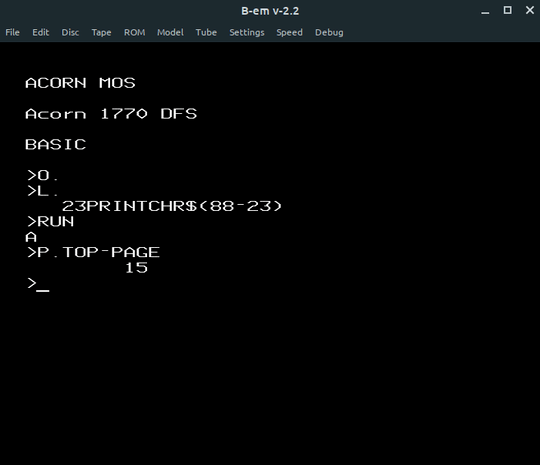72
16
Your task is to display the letter "A" alone, without anything else, except any form of trailing newlines if you cannot avoid them, doing so in a program and/or snippet. Code that returns (instead of printing) is allowed.
Both the lowercase and uppercase versions of the letter "A" are acceptable (that is, unicode U+0061 or unicode U+0041. Other character encodings that aren't Unicode are allowed, but either way, the resulting output of your code must be the latin letter "A", and not any lookalikes or homoglyphs)
You must not use any of the below characters in your code, regardless of the character encoding that you pick:
"A", whether uppercase or lowercase.
"U", whether lowercase or uppercase.
X, whether uppercase or lowercase.
+
&
#
0
1
4
5
6
7
9
Cheating, loopholes, etc, are not allowed.
Since this is code-golf, the shortest solution, in bytes, that follows all the rules, is the winner.
Validity Checker
This Stack Snippet checks to make sure your code doesn't use the restricted characters. It might not work properly for some character encodings.
var t = prompt("Input your code.");
if (/[AaUuXx+𣤏]/.test(t)) {
alert("Contains a disallowed character!");
} else {
alert("No disallowed characters");
}This Stack Snippet that makes sure you don't have a disallowed character is also available on JSFiddle.
Leaderboard
var QUESTION_ID=90349,OVERRIDE_USER=58717;function answersUrl(e){return"https://api.stackexchange.com/2.2/questions/"+QUESTION_ID+"/answers?page="+e+"&pagesize=100&order=desc&sort=creation&site=codegolf&filter="+ANSWER_FILTER}function commentUrl(e,s){return"https://api.stackexchange.com/2.2/answers/"+s.join(";")+"/comments?page="+e+"&pagesize=100&order=desc&sort=creation&site=codegolf&filter="+COMMENT_FILTER}function getAnswers(){jQuery.ajax({url:answersUrl(answer_page++),method:"get",dataType:"jsonp",crossDomain:!0,success:function(e){answers.push.apply(answers,e.items),answers_hash=[],answer_ids=[],e.items.forEach(function(e){e.comments=[];var s=+e.share_link.match(/\d+/);answer_ids.push(s),answers_hash[s]=e}),e.has_more||(more_answers=!1),comment_page=1,getComments()}})}function getComments(){jQuery.ajax({url:commentUrl(comment_page++,answer_ids),method:"get",dataType:"jsonp",crossDomain:!0,success:function(e){e.items.forEach(function(e){e.owner.user_id===OVERRIDE_USER&&answers_hash[e.post_id].comments.push(e)}),e.has_more?getComments():more_answers?getAnswers():process()}})}function getAuthorName(e){return e.owner.display_name}function process(){var e=[];answers.forEach(function(s){var r=s.body;s.comments.forEach(function(e){OVERRIDE_REG.test(e.body)&&(r="<h1>"+e.body.replace(OVERRIDE_REG,"")+"</h1>")});var a=r.match(SCORE_REG);a&&e.push({user:getAuthorName(s),size:+a[2],language:a[1],link:s.share_link})}),e.sort(function(e,s){var r=e.size,a=s.size;return r-a});var s={},r=1,a=null,n=1;e.forEach(function(e){e.size!=a&&(n=r),a=e.size,++r;var t=jQuery("#answer-template").html();t=t.replace("{{PLACE}}",n+".").replace("{{NAME}}",e.user).replace("{{LANGUAGE}}",e.language).replace("{{SIZE}}",e.size).replace("{{LINK}}",e.link),t=jQuery(t),jQuery("#answers").append(t);var o=e.language;/<a/.test(o)&&(o=jQuery(o).text()),s[o]=s[o]||{lang:e.language,user:e.user,size:e.size,link:e.link}});var t=[];for(var o in s)s.hasOwnProperty(o)&&t.push(s[o]);t.sort(function(e,s){return e.lang>s.lang?1:e.lang<s.lang?-1:0});for(var c=0;c<t.length;++c){var i=jQuery("#language-template").html(),o=t[c];i=i.replace("{{LANGUAGE}}",o.lang).replace("{{NAME}}",o.user).replace("{{SIZE}}",o.size).replace("{{LINK}}",o.link),i=jQuery(i),jQuery("#languages").append(i)}}var ANSWER_FILTER="!t)IWYnsLAZle2tQ3KqrVveCRJfxcRLe",COMMENT_FILTER="!)Q2B_A2kjfAiU78X(md6BoYk",answers=[],answers_hash,answer_ids,answer_page=1,more_answers=!0,comment_page;getAnswers();var SCORE_REG=/<h\d>\s*([^\n,]*[^\s,]),.*?(\d+)(?=[^\n\d<>]*(?:<(?:s>[^\n<>]*<\/s>|[^\n<>]+>)[^\n\d<>]*)*<\/h\d>)/,OVERRIDE_REG=/^Override\s*header:\s*/i;body{text-align:left!important}#answer-list,#language-list{padding:10px;width:290px;float:left}table thead{font-weight:700}table td{padding:5px}<script src="https://ajax.googleapis.com/ajax/libs/jquery/2.1.1/jquery.min.js"></script> <link rel="stylesheet" type="text/css" href="//cdn.sstatic.net/codegolf/all.css?v=83c949450c8b"> <div id="answer-list"> <h2>Leaderboard</h2> <table class="answer-list"> <thead> <tr><td></td><td>Author</td><td>Language</td><td>Size</td></tr></thead> <tbody id="answers"> </tbody> </table> </div><div id="language-list"> <h2>Winners by Language</h2> <table class="language-list"> <thead> <tr><td>Language</td><td>User</td><td>Score</td></tr></thead> <tbody id="languages"> </tbody> </table> </div><table style="display: none"> <tbody id="answer-template"> <tr><td>{{PLACE}}</td><td>{{NAME}}</td><td>{{LANGUAGE}}</td><td>{{SIZE}}</td><td><a href="{{LINK}}">Link</a></td></tr></tbody> </table> <table style="display: none"> <tbody id="language-template"> <tr><td>{{LANGUAGE}}</td><td>{{NAME}}</td><td>{{SIZE}}</td><td><a href="{{LINK}}">Link</a></td></tr></tbody> </table>



7@ColdGolf You seem to be saying "yes" to functions, but functions don't display, they usually return. – xnor – 2016-08-19T23:06:04.653
2Is ending up with a variable that contains just
aalso good enough ? – Ton Hospel – 2016-08-19T23:17:51.7971That's not what I meant. The supposed code doing a variable assignment would not contain any of the forbidden characters. I'm just trying to understand what is covered by "display by means other than printing". If "return from a function" is OK, what about "assign to a variable" ? – Ton Hospel – 2016-08-20T00:05:02.067
I was going to post an answer in detour, then I realized the only cell that can print strings is
u. :/ – Cyoce – 2016-08-21T06:50:51.1231Why those particular characters? – user253751 – 2016-08-22T01:32:08.380
7@immibis
Afor obvious reasons.Ufor Unicode escape strings (\u0041isA),Xfor hex escape strings (\x41),+for Unicode ordinals (U+0041),&for HTML entities,#for I actually don't know,65is the decimal ordinal ofA,41is the hex ordinal ofA,97is the decimal ordinal ofa, and0for a few of the previous reasons. – Mego – 2016-08-22T06:26:11.7171@Mego don't forget the number "10" cast into hex is "A". --> %x, -~9 – Albert Renshaw – 2017-01-26T04:24:31.970
Aww, impossible in Shakespeare Programming Language because you have to declare
Acts – Hello Goodbye – 2019-12-27T14:41:42.000